Objects To Treasure in Barnsley
12th October 2017
Every Thursday we’ll be sharing an object to treasure in Barnsley. Keep up to date on our Facebook page.
27th September

This is a ‘Cannon Hall’ vase, specially designed by Sian Leeper in 2007 and inspired by the museum’s gardens. It is part of a large collection of Moorcroft pottery on display in the Cannon Hall Museum collection.
20th September

This flower-shaped brooch dates back to 1950. It is one of several pieces of jewellery in the collection which belonged to Eva Burnett, a ballroom dancer from Barnsley. The brooch can be found in the Experience Barnsley Museum collection.
13th September

This 19th-century painting is ‘A Street in Lerici’ by Frederic Lord Leighton. Leighton was born in Scarborough but had his artistic training in Italy and France. This painting is a street scene in Lerici, a small town on the Italian Riviera. It is part of the Cooper Gallery Trustees collection.
6th September

This Bronze figurine, sculpted by artist Gertrude Spencer-Stanhope, dates back to 1900. Gertrude, who lived at Cannon Hall, was one of several family members with great artistic talent. This example of her work is part of the Cannon Hall Museum collection.
30th August

This linen glass cloth dates back to 1900. ‘Barnsley Linen’ is printed on each red band – linen was a big Barnsley industry alongside coal and glass until it began to decline in the mid 19th century. This example is part of the Experience Barnsley Museum collection.
23rd August

This 19th-century painting by Alberto Pasini is known as ‘The Grimani Palace, Venice’. Best known as an Orientalist painter, this is one of the examples of his Impressionist style, using the light and reflection of the water, and the texture and colours of a decaying building. The painting is part of the Cooper Gallery Trustees collection.
16th August

This is a ‘Coalbrookdale’ ceramic bowl (c.1810) by Coalport China. Coalbrookdale is a village in the Ironbridge Gorge in Shropshire. It is also the name coined by Coalport China for one of their most desirable and decorative styles of china. This bowl is coloured in claret, pink and gilt, and decorated with flowers inside and outside. Coalbrookdale is known for inspired use of colour and for flamboyant decoration. It’s part of the Cannon Hall Museum collection.
9th August

This ink and watercolour is called ‘Taormina’ (1847) by Edward Lear. Lear was an English artist and author, producing many satirical and comical illustrations along with ‘The Book of Nonsense’ in 1846. He was almost entirely self-taught in painting and from 1836 devoted himself to landscape painting. He spent long periods travelling, often to remote places. The church depicted in this watercolour is St Michele in Sicily. The church sits at the top of a steep gorge. The painting is part of the Cooper Gallery Trustees collection.
2nd August

This Bohemian Glass Jar and Cover dates back to 1840. Bohemia, now part of the Czech Republic, has been an international glassmaking centre for hundreds of years. This jar and cover is decorated with pastel colours forming a shell design of pale blue, red and amber. It is part of the Cannon Hall Museum collection.
26th July

This is ‘Portrait of a Girl, aged 19’, a painting by Hendrick Gerritsz Pot, dating back to 1630. It’s one of many examples of Pot’s portraits which were all of a similar size and shape with the subject in the same pose. This painting is part of the Dutch Golden Age exhibition, which is free to visit at Cannon Hall Museum until 16th September.
19th July

This bar of Pit Head bath soap would have made a great impact on the lives of miners and their families. Many pit baths were built in the 1930s and meant that miners could clean up straight after finishing work and get out of their dirty and damp clothes before going home. This soap is part of the Experience Barnsley Museum collection.
12th July
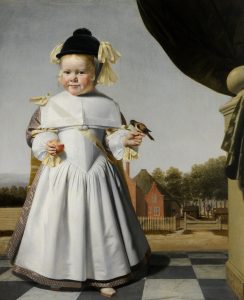
This is ‘Child Holding an Apple’, a painting by Caesar van Everdingen dating back to 1664. It’s an unusual example of his own work but many portraits of children were produced during this period. This painting is part of the Dutch Golden Age exhibition, which is free to visit at Cannon Hall Museum until 16th September.
5th July

This painting by French artist Charles Theodore Frère is known as ‘Café de Galata, Constantinople’. This panting is quite unusual for Frère as it shows an indoor scene and is larger than many of his works. It can be found as part of the Cooper Gallery Trustees collection.
28th June

This oil on canvas painting is known as ‘Landscape with Figures, Evening’ and was painted by Jan & Andries Both in the 17th century. It is a typically beautiful view framed by trees with the hazy atmosphere of the Roman Campagna painted by Jan, while Andries was responsible for the figures. This painting is part of the Dutch Golden Age exhibition, which is free to visit at Cannon Hall Museum until 16th September.
21st June

This painting is known as ‘Mrs Tuder’ and dates back to 1818. It was painted by John Constable and is one of many examples of his portraits from the early 19th century, before he had more success with landscape paintings. This oil on canvas painting is part of the Cannon Hall Museum collection.
14th June

These are two metal identity badges from Dachau Concentration Camp, dating back to the 1940s. They belonged to Stanley Zasada, a Polish Catholic imprisoned in Dachau during the Second World War. Mr Zasada came to the Polish camp at Cawthorne after the war, and eventually worked in the mines as an engineer. His badges are part of the Experience Barnsley Museum collection.
7th June

This painting is called ‘Atcham Church, Shrewsbury’ and was painted by Peter de Wint in the early 1800s. De Wint was one of the best-known British watercolour artists and this painting is typical of his style. It is part of the Cooper Gallery Trustees collection.
31st May
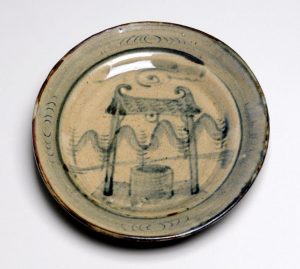
This Stoneware Dish was made by Bernard Leach around 1930. Leach is regarded as the best known and most prominent of British studio potters, with this dish showing the influence of his early years in Japan. It is part of the Cannon Hall Museum collection.
24th May

This glass swan was made by local glassmaker Wood Brothers in the early 20th century. It was common for swans to be made out of leftovers glass by apprentices as the glass industry boomed in Barnsley and the Dearne Valley. This one is part of the Experience Barnsley Museum collection.
17th May

This 19th century painting by Cawthorne artist Abel Hold is known as ‘Peggy Airey’. Peggy was a well-known Barnsley character who sold pegs in the town in the 1800s. The painting is part of the Cooper Gallery trustees collection.
10th May

This Mahogany Chair dates back to 1780. It is a George Hepplewhite style and one of six chairs dating from the late 18th century, when these designs were the height of fashion. This chair is part of the Cannon Hall Museum collection.
3rd May
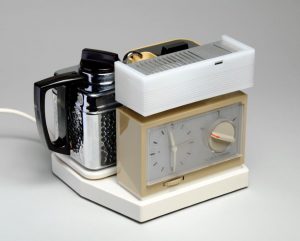
This Goblin Teasmade dates back to the 1960s, when the teamaking machines were in their heyday. Goblin were the major manufacturer and first used the word ‘teasmade’ as a trademark. This one is part of the Experience Barnsley Museum collection.
26th April

This painting is called ‘Interior of the Mosque of Suleiman the Magnificent, Constantinople’. Painted by artist John Frederick Lewis in the 19th century, this wonderfully detailed architectural artwork is part of the Cooper Gallery Trustees collection.
19th April

This ‘Castello’ bowl was made by Helena Tynell around 1960. It was made for the Finnish company Riihimaki and is one example of the modern Scandinavian glass collection at Cannon Hall Museum.
12th April

This Crown and Anchor dice and shaker dates back to the First World War. It was owned by Albert Eeles, a Barnsley soldier who fought in the war. Crown and Anchor was first played in the 18th century by sailors in the Royal Navy. This set can be found in the Experience Barnsley Museum collection.
5th April

This 19th-century painting is known as ‘The Hospice of St Bernard, Great St Bernard Pass’. It was created by artist John Ruskin, who was famous for being both an artist and art critic. The painting is part of the Cooper Gallery Trustees collection.
29th March

This painting is known as ‘Sarah Wynne, Lady Houblon’ by Sir Peter Lely. It dates back to the 17th century and is typical of Lely’s style with the rich silken dress, still pose and the landscape as a backdrop. The painting is part of the Cannon Hall Museum collection.
22nd March
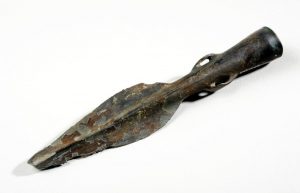
This spearhead dates back to the Bronze Age, 1400-1000 BC. Barnsley holds a small collection of prehistoric archaeology, showing the long history of human activity in the borough. This spear is part of the Experience Barnsley Museum collection.
15th March

This wine glass dates back to 1905 and was manufactured by glassmakers James Powell and Sons. Also known as Whitefriars Glass, the company were known for making stained glass windows, leadlighters and glasses. This particular glass is part of the Cannon Hall Museum collection.

This portrait of King Henry VIII, one of England’s best known monarchs, dates back to the 17th century. It is one of a pair of portraits in the Cooper Gallery Trustees Collection, the other one being of Queen Elizabeth I.
1st March

This oil on canvas painting is ‘Interior of a Courtyard’ and dates back to 1765. It was painted by Giovanni Antonio Canaletto, one of the most famous Italian view painters who was famous for his detail of architecture and contrast of light and shade. This piece is part of the Cannon Hall Museum collection.
22nd February

This bicycle was owned by Barnsley Master Butcher Albert Hirst, and was used to make many meat deliveries. Hirst is credited with the ‘Barnsley Chop’, a special dish served to HRH the Prince of Wales when he opened Barnsley Town Hall in 1933. The bike is part of the Experience Barnsley Museum collection.
15th February

This painting, by British artist Wyndham Tyron, is known as ‘The Church of the Knights Templar, Segovia, Spain’. It was painted in 1910 and is part of one of the most important collections of British Art in the country. It is on display in the Cooper Gallery’s Trustees collection.
8th February

These vases date back to 1875 and were made by Minton, one of the largest Victorian ceramic manufacturers. They were made using the ancient ‘cloisonné’ technique, which was used for decorating metalwork and later developed for use on ceramics. The vases can be found at Cannon Hall Museum.
1st February

This red tin set dates back to the 20th century and was taken to the coal pit every day by the donor’s father. The teapot, cup and strainer were just as important as the equipment the miners used, as keeping refreshed was vital in the conditions they worked in. It is part of the collection at Experience Barnsley Museum.
25th January
This painting is known as ‘The Doge’s Palace, Venice’ by Louis Desire Thienon. It is an excellent example of the French artist’s work dating back to the mid-1800s. The painting is now part of the Cooper Gallery Trustees collection.

18th January
This Pewter centrepiece shows a nymph holding a dove. It dates back to 1895 and is a perfect example of Art Nouveau style. It was made by the German manufacturer Wurttembergische Metallwarenfabrik, and is now part of the Cannon Hall Museum collection.
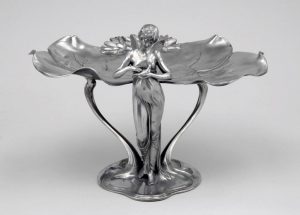
11th January
Today is the Heritage Lottery’s #HeritageTreasures day. To celebrate, we’ve put together our top three heritage treasures from Barnsley. Use the hashtags #HeritageTreasures and #LoveHeritage to share yours with us on Twitter @BarnsleyMHT
The first is this knitted peaked hat worn by Stan Richards in almost every scene he played as ‘Seth Armstrong’ in Emmerdale – now on display at Experience Barnsley Museum.

The second is this vase designed by Sian Leeper for Moorcroft and inspired by the gardens at Cannon Hall Museum.
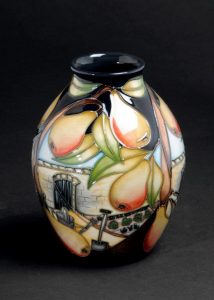
Our third treasure is this flower shaped brooch – one of several pieces in a collection of jewellery belonging to Eva Burnett, a ballroom dancer from Barnsley. Now on display at Experience Barnsley Museum.

4th January
‘Study of a Seated Boy’ by Adriasen van de Velde (1636 – 1672) is a simple pencil and wash on paper painting from the Dutch artist. Van de Velde was from Amsterdam and was employed by other artists to supply figures for their paintings. This artwork is part of the Cooper Gallery Trustees collection.

21st December
‘Flowerpiece’ by Jan van Huysum (1682-1749) is a brilliantly colourful oil on canvas and a fine example of a Dutch masterpiece. Van Huysum was from Amsterdam and was internationally famous in his own lifetime. More examples of his work can be seen in the National Gallery, London and the Louvre, Paris. This piece is part of the Cannon Hall Museum collection.
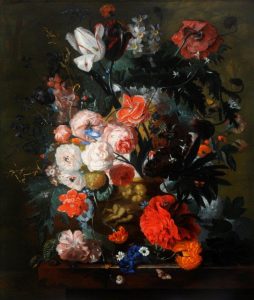
14th December
This helmet is from the Women Against Pit Closures movement (1984-85). It is a strong visual reminder of the Miners’ Strike, one of the most troubled times in Barnsley’s modern history. It is part of the collection at Experience Barnsley Museum.

7th December
This oil on canvas is called ‘The Beggar Girls’ by Pierre Auguste Cot (1837-1883). Cot studied in Toulouse then based himself in Paris. His classical style was popular and he became a great success in Europe and America. The piece is now part of the Cooper Gallery Trustees collection.

30th November
This cabinet dates back to 1685. It has a body made from deal and drawers made from oak, with a cocus wood veneer sometimes called Jamaica ebony. It is part of Cannon Hall Museum’s collection.

23rd November
This Egyptian Design tin is one of dozens of colourful and characterful tins from the Canister Company in Barnsley’s collections. It is part of the collection at Experience Barnsley Museum.

16th November
This sketch, by world famous artist Joseph Mallord William Turner, is known as ‘A View of Old Bregenz, Austria’. It is part of the Cooper Gallery Trustees collection.

9th November
This vase is from the late 19th century and was made by French glass artist Emile Gallé. He was one of the major figures in the French Art Nouveau movement. It is now part of the Cannon Hall Museum collection.

2nd November
This Bronze Roman bracelet is from the 2nd to 3rd century AD. An archaeological find from Billingley and one of several pieces of evidence of Roman life in Barnsley. It is now part of the collection at Experience Barnsley Museum.
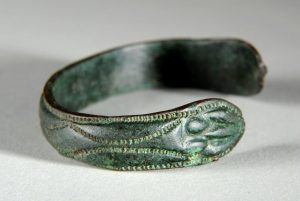
26th October
This oil painting called ‘Hurricane before St Malo’ is by Eugène Louis Gabriel Isabey (1803-1886).
The large and dramatic painting is one of several by Isabey collected by Samuel Joshua Cooper of Barnsley. It is now part of the Cooper Gallery Trustees’ collection.

19th October
This vase was made by Joe Juster for William de Morgan, c.1890. It’s an example of work from the Arts and Crafts period, an influential movement advocating the quality of art, design and life in the face of mass industrialisation.
This piece has come from the V&A and is now part of the collection at Cannon Hall Museum.

12th October
The first in our Objects To Treasure series. The Death Penny from the First World War can be found in the Experience Barnsley: Museum & Discovery Centre collection.
Private Harry Sargeant from Barnsley died in action in France in May 1917. He was 26 years old and worked at Rylands before the war.








